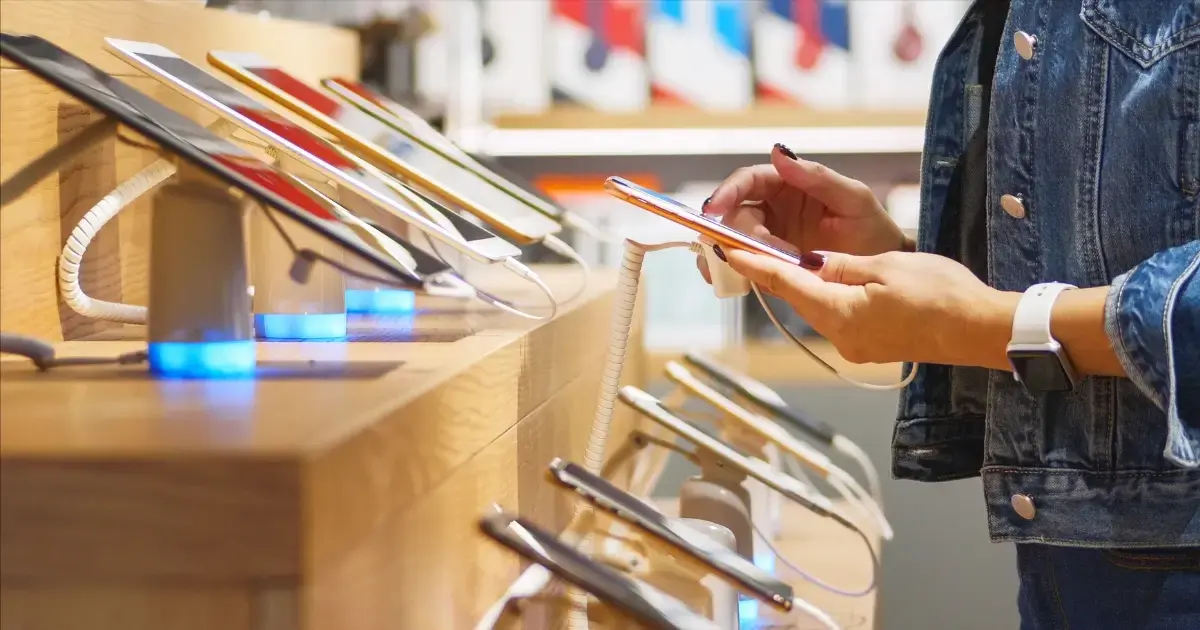Despite the e-commerce craze, brick-and-mortar retail is alive and well. Customers still appreciate the in-store shopping experience — but if you want your electronics store to thrive, you need to provide a layout and design that highlights the unique advantages of in-store shopping.
In other words: You need to implement some creative electronic store design ideas.
Behind every high-performing electronics store is a deliberate design strategy that guides customer behavior. Major chains have perfected these techniques through extensive research, but independent retailers can get in on the action, too — and without the expensive research price tag.
This blog delivers seven proven design strategies that transform electronic retail spaces into sales machines.
Electronics Store Design Ideas: Why Design Matters
Electronics stores have evolved from warehouse-style stores to curated brand environments that blend technology, support, and entertainment. The market leaders take different approaches — from Apple’s minimalist design to Best Buy’s in-store experiences — but they’re all trying to accomplish the same thing: keeping brick-and-mortar engagement in an increasingly online-shopping-first market.
So, how important is design? Let’s take a look at the stats. Research shows that a well-designed, immersive store can boost sales by up to 540% compared with a disorganized store. When your store is comfortable with a logical layout, you can increase customer engagement and dwell time, ultimately boosting sales and customer satisfaction.
Related Read: 3 Top Electronics Store Management Software [Features + Pricing]
The more popular e-commerce becomes for electronics sales, the more important in-store experience becomes for brick-and-mortar stores. Customers looking to purchase electronics in store are looking for a convenient, education-centered shopping experience.
The most successful retailers recognize that modern electronics stores are more than just distribution points. Customers need to be able to meaningfully engage with products and easily navigate your store, and you should design your electronics store with these insights in mind.
1. Zone Products Strategically
One of the most critical electronic store design elements is layout and zoning. Strategic product zoning transforms an overwhelming warehouse into an easy-to-navigate store. Let’s examine some strategies for zoning products:
- Create distinct product categories: Divide products into categories like audio, computing, mobile, and gaming. Then, use contrasting colors or unique fixtures in each section to visually separate them from one another.
- “Good, better, best” arrangement strategy: Use consumer psychology to boost average sale values by presenting products in ascending price and feature tiers within each category. This layout helps customers self-select their appropriate investment level. This tiered approach works particularly well for accessories like headphones, speakers, and phone cases where feature differentiation is tangible.
- Use heat mapping technology: Use heat mapping tools to track dwell time, touch interactions, and conversion patterns throughout the store, identifying high-value zones for premium merchandise.
Research also shows that 90% of Americans instinctively turn right when they enter a store, so the space directly to the right of your entry point is prime real estate for a high-margin product zone.

2. Add Interactive Demo Stations
Brick-and-mortar electronics stores survive based on customer engagement, so you need to make your store into an experience rather than just a passive distribution center. Another key design element is adding demonstration stations to your floor plan.
Effective demo zones should balance compelling technology presentation with comfortable user interaction space. The most successful implementations feature waist-height counters (36–42 inches) that encourage natural product handling.
Keep in mind that continuously staffed stations drive higher conversion rates. The staffing costs of this approach can be steep, so you may want to consider a hybrid approach — scheduled demonstration times during peak hours combined with self-guided demos during off hours.

Related Read: 6 Resources for Small Business Owners To Use in the New Year
3. Consider Lighting Psychology for Electronics
Lighting psychology can impact sales and conversion rates across industries, and electronics stores are no exception.
Cool white lighting (5,000–6,500K) boosts the technical appearance of computing and mobile products, making specification details more readable and screens more vibrant. Conversely, mid-range temperatures (3,500–4,500K) better showcase the rich materials and finishes of premium headphones and speakers.
Spotlight techniques can also effectively highlight premium products and automatically guide customer eyes to the highest-margin merchandise. You want your spotlights to be 3–5 times brighter than your ambient lighting. This ratio creates the “spotlight” effect without creating a harsh visual transition for your customers.

Related Read: Harnessing POS and CRM for Your Mobile Phone Store: 3 Sales-Boosting Tips
4. Consider Traffic Flow
An engaging electronics store is easy to navigate. You want to consider traffic flow when laying out your store.
Related Read: How To Increase Foot Traffic to Your Business: 5 Amazing Ideas
The most effective layouts implement primary pathways 5–7 feet wide to accommodate multidirectional traffic while maintaining clear sightlines across the store. These main paths should feature distinct flooring material or color to subconsciously guide customer movement, while accommodating natural gathering points near high-interest displays.
Strategic placement of impulse purchase items throughout these pathways significantly impacts attachment rates. While traditional retail wisdom concentrates impulse items at checkout, you can see boosts in sales when you distribute these displays around your store, using a method called “speed bump” displays.
These low-height, high-visibility fixtures positioned at natural pause points (corners, transitions between departments) typically feature accessories under $50. Positioning these items near the high-ticket items they pair with can boost basket sizes and create a more convenient shopping experience for your customers.
5. Create a Modular Display Strategy
The world of electronics changes and evolves fast. If you want to keep up with those ever-shifting product cycles, you may want to invest in modular displays. These solutions feature adjustable shelving and reconfigurable power setups, allowing for quick merchandising updates without significant investment.
Another benefit of a modular setup is that these shelving units can give small-footprint electronics stores an advantage. You can use wall systems with adjustable brackets to display more products vertically, optimizing your floor plan without visually crowding your space.
6. Integrate Online and Offline Shopping
We’re talking about brick-and-mortar retail, but if you want to succeed, you should consider integrating your physical store with your online store for a seamless omnichannel experience.
Effective integrations feature intuitive touchscreen interfaces, integrated payment processing, and clear fulfillment options including home delivery or in-store pickup. You can position kiosks at natural decision points where customers might encounter selection limitations, such as at the ends of physical product displays or near service counters.
One of the most critical elements of integrating online and offline shopping is investing in the right analytics, inventory management, and point of sale (POS) tools. Unified systems that connect online browsing, multichannel inventory, and in-store sales can help you manage your store across channels without breaking a sweat.
CellSmart POS stands out by integrating all online and offline sales data in an all-in-one tool. This allows retailers to identify customer patterns whether customers are shopping online or in person.
7. Optimize Your Checkout Stations
Accepting multiple payment types isn’t optional anymore — it’s table stakes.
Beyond standard credit and debit processing, modern checkout stations must accommodate contactless payments, mobile wallets (Apple Pay, Google Pay, Samsung Pay), and installment or layaway options.
Investing in an all-in-one POS solution with built-in features for customer loyalty programs, payment processing, inventory management, and more helps streamline the checkout process and reduce wait times in your store.
In terms of design, your checkout areas should implement serpentine single-line configurations rather than multiple parallel lines, as research consistently shows customers perceive single lines as more fair and efficient despite identical actual wait times. This setup also takes up less space and leaves more floor space for merchandise.

Bonus tip: Integrating repair tracking with checkout systems creates valuable cross-selling opportunities. These integrated systems allow staff to seamlessly transition from checkout to repair consultation without changing applications. CellSmart POS offers automated repair notifications, customer history tracking, and seamless payment processing for both product sales and service.
Electronic Store Design Ideas: Implementation Strategy
Are you unsure where to start implementing your new electronic store designs? Here’s a simple, step-by-step checklist you can use to implement your new design and start enjoying the benefits.
Phase 1: Assessment and Planning (4–6 Weeks)
1. Conduct store performance analysis.- Review current sales metrics by department and product category.
- Identify underperforming areas and high-margin opportunities.
- Analyze customer feedback for pain points and improvement suggestions.
- Implement temporary heat mapping technology or conduct manual observation studies.
- Document current customer pathways and identify bottlenecks.
- Measure dwell time in different store zones.
- Inventory all display units, lighting systems, and technology infrastructure.
- Assess condition, flexibility, and remaining useful life of current elements.
- Identify reusable components to control renovation costs.
Phase 2: Quick Wins Implementation (1–2 Months)
1. Optimize product zoning.- Reorganize merchandise into clearer category groupings.
- Implement "good, better, best" product arrangements within categories.
- Position high-margin items in prime zones identified through heat mapping.
- Adjust color temperature in different departments to match product categories.
- Add spotlighting to premium products and focal points.
- Clean and realign existing fixtures for maximum effectiveness.
- Create a consistent three-tier signage system (identification, features, promotions).
- Install clear department markers and directional guidance.
- Update price tags and promotional materials for clarity and impact.
- Conduct workshops on optimized customer journey and product storytelling.
- Establish new procedures for maintaining visual standards.
- Implement daily department checklists for consistency.
Phase 3: Technology Integration (2–3 Months)
1. Deploy digital price tags and information displays.- Implement dynamic digital signage for promotional flexibility.
- Create QR linking systems between physical products and digital information.
- Set up performance dashboards for ongoing optimization.
- Establish customer feedback collection points throughout the store.
- Ensure seamless inventory visibility across channels.
- Enable cross-channel returns and exchanges.
- Integrate customer profiles for personalized service.
How To Make the Most of These Electronic Store Design Ideas
Using these electronic store design ideas, you can create a store with strong product zoning, incredible interactive experience, and intuitive traffic flow — but if you really want to succeed, design alone isn’t enough.
If you want to run a thriving electronics business, you need the right tools and processes to streamline operations, understand customer behavior, and manage staff and repairs. And the best tool for the job is an integrated point of sale solution like CellSmart POS.
CellSmart POS offers electronics retailers a comprehensive solution that does way more than just process payments. With built-in repair tracking, inventory management across channels, customer relationship tools, and performance analytics, we provide the technological foundation that makes great design truly effective.
Schedule a demo of CellSmart POS today to discover how the right technology platform can help you maximize returns on your store design investment.




